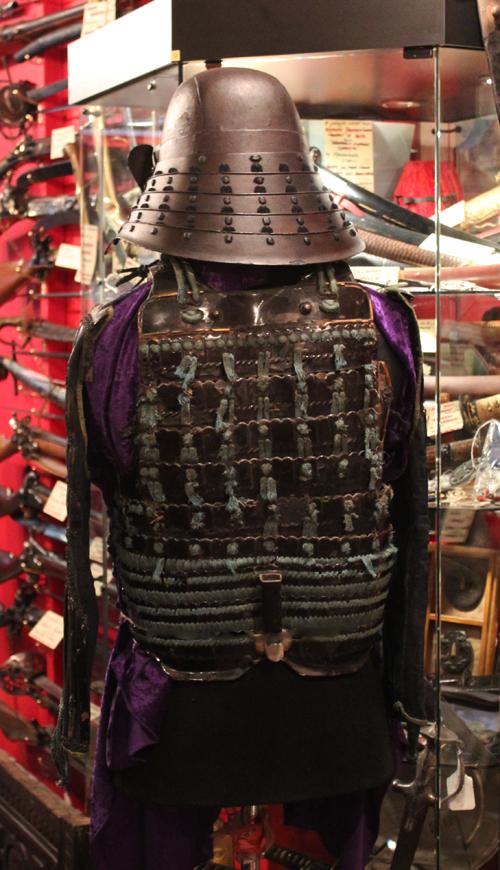A Fine Edo Period 17th Cent. Samurai Armour Gosuko, Dangae dou Part Suit of Armour. Shown With A Kabuto For Display Only, {Kabuto Now Sold}
17th century body armour {kabuto helmet sold seperately} comprising full a cuirass {do}, of front and back plates, constructed of iron plates over lacquered and fully laced, and linked with chain mail.
Dangae dou (dō) meaning "step-changing" is a Japanese (samurai) chest armor that is a combination of two or more other styles. The main part of the dou (dō) may be an okegawa dou (dō), but the bottom two lames are laced (kebiki or sugake) instead of riveted or vice versa, or an armour is laced in sugake but the tateage and bottom lames are in kebiki.
Plus, steel chain mail and armour plate arm defences, inner lined with blue green material. The kabuto we show in photos 4 and 5, would compliment it beautifully, and for sale separately {code number 24030}.
During the Heian period (794-1185), the Japanese cuirass evolved into the more familiar style of armour worn by the samurai known as the dou or do. Japanese armour makers started to use leather (nerigawa) and lacquer was used to weather proof the armor parts. By the end of the Heian period the Japanese cuirass had arrived at the shape recognized as being distinctly samurai. Leather and or iron scales were used to construct samurai armours, with leather and eventually silk lace used to connect the individual scales (kozane) which these cuirasses were now being made from.
In the 16th century Japan began trading with Europe during what would become known as the Nanban trade. Samurai acquired European armour including the cuirass and comb morion which they modified and combined with domestic armour as it provided better protection from the newly introduced matchlock muskets known as Tanegashima. The introduction of the tanegashima by the Portuguese in 1543 changed the nature of warfare in Japan causing the Japanese armour makers to change the design of their armours from the centuries-old lamellar armours to plate armour constructed from iron and steel plates which was called tosei gusoku (new armours). Bullet resistant armours were developed called tameshi gusoku or (bullet tested) allowing samurai to continue wearing their armour despite the use of firearms. Please note the helmet is not with the armour. The silk lacing on the breast and back plate is 400 years old and very frayed throughout.
In Japan the term samurai evolved over several centuries
In Japanese, they are usually referred to as bushi (武士,) or buke (武家). According to translator William Scott Wilson: "In Chinese, the character 侍 was originally a verb meaning 'to wait upon', 'accompany persons' in the upper ranks of society, and this is also true of the original term in Japanese, saburau. In both countries the terms were nominalized to mean 'those who serve in close attendance to the nobility', the Japanese term saburai being the nominal form of the verb." According to Wilson, an early reference to the word samurai appears in the Kokin Wakashū (905–914), the first imperial anthology of poems, completed in the first part of the 10th century.
Originally, the word samurai referred to anyone who served the emperor, the imperial family, or the imperial court nobility, even in a non-military capacity.It was not until the 17th century that the term gradually became a title for military servants of warrior families, so that, according to Michael Wert, "a warrior of elite stature in pre-seventeenth-century Japan would have been insulted to be called a 'samurai'".
In modern usage, bushi is often used as a synonym for samurai
Code: 20178
2850.00 GBP



